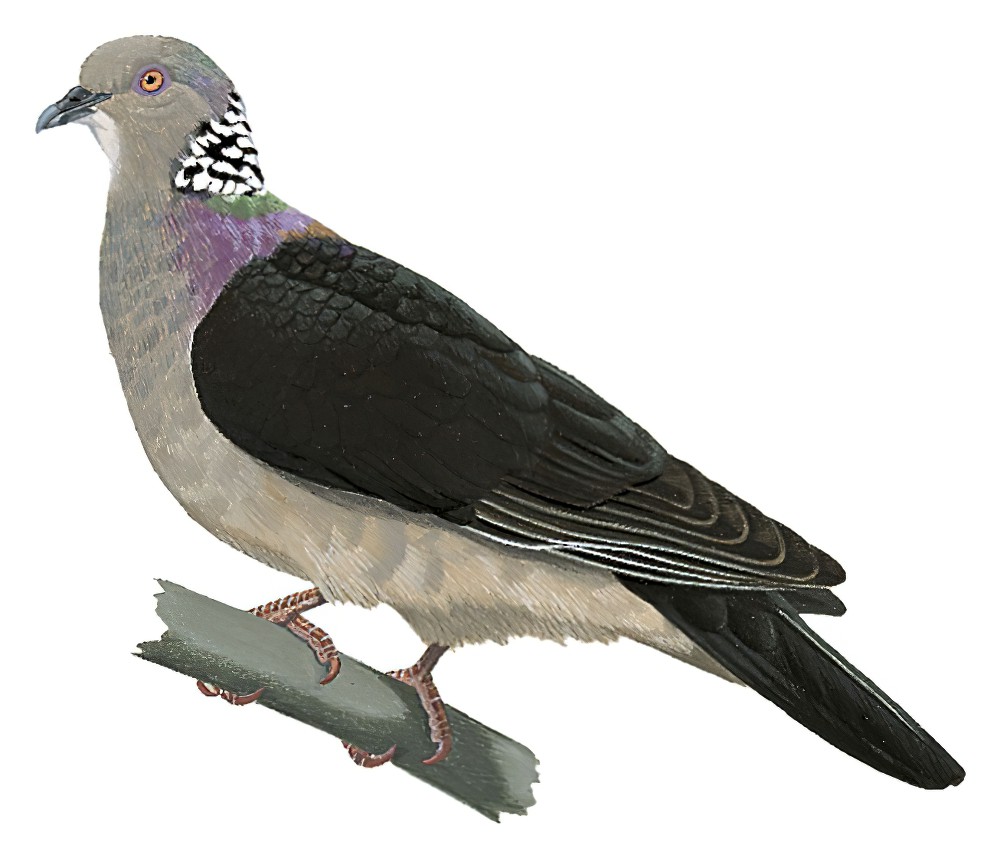Sri Lanka Wood-Pigeon / Columba torringtoniae

Sri Lanka Wood-Pigeon
SCI Name:
Protonym: Palumbus Torringtoni ProdromusFaunaeZeylanicae Append.C Append.C p.35
Taxonomy: Columbiformes / Columbidae / Columba
Taxonomy Code: ceywop1
Type Locality:
Author: Blyth & Kelaart
Publish Year: 1853
IUCN Status: Vulnerable
DEFINITIONS
COLUMBA
(Columbidae; Ϯ Stock Dove C. oenas) L. columba pigeon; "92. COLUMBA. Rostrum rectum, versus apicem descendens. Nares oblongæ, membrana molli tumida semitectæ. Lingua integra. ... Columbas ad Passeres nec ad Gallinas pertinere, docet monogamia, osculatio, incubatus alternus, nutritio pulli, Ova pauca, nidificatio, locus in altis." (Linnaeus 1758); "Columba Linné, Syst. Nat., ed. 10, 1, 1758, p. 162. Type, by subsequent designation, Columba oenas Linné. (Vigors, 1825.)" (Peters, 1937, III, p. 56). Linnaeus's Columba comprised twenty-two species (C. Oenas, C. gutturosa, C. cucullata, C. Turbita, C. tremula, C. tabellaria, C. montana, C. asiatica, C. guinea, C. hispanica, C. Palumbus, C. cyanocephala, C. leucocephala, C. leucoptera, C. nicobarica, C. macroura, C. sinica, C. indica, C. hispida, C. Turtur, C. risoria, C. passerina).
Var. Culumba, Collumba, Columbus, Colomba, Columra, Coulmba.
Synon. Alsocomus, Amauroenas, Coelotreron, Dendrotreron, Dialiptila, Janthoenas, Leucoenas, Leucomeloena, Leucotaenia, Lithoenas, Livia, Palumbis, Palumboena, Palumbus, Peleioenas, Raperia, Stictoenas, Sylvicola, Taenioenas, Trocaza, Tryzusa, Turturoena.
columba
● Icelandic Klumba auk; “Columba groenlandica Auctorum” (Pallas 1811) (“The Greenland Dove or Sea-Turtle; Columba Groenlandica” described by Ray 1713, is the Black Guillemot C. grylle; “Why they call it a Dove or Turtle I cannot certainly tell. It is indeed about the bigness of a Turtle, and lays (they say) two Eggs at once like them, and possibly there may be some agreement in their voice or note”) (Cepphus).
● L. columba pigeon; "Fulmarus glacialis columba, subsp. nov. PIGEON FULMAR. ... General plumage white. Mantle pearly gray, rather darker than light phase of glupischa in my collection." (Anthony 1895) (syn. Fulmarus glacialis rodgersii).
Colymbus
Gr. κολυμβις kolumbis, κολυμβιδος kolumbidos unknown water-bird, probably a grebe.
• (Gaviidae; syn. Gavia † Black-throated Diver G. arctica) "68. COLYMBUS. Rostrum edentulum, subulatum, rectum, acuminatum. Pedes pone æquilibrium. ... Colymbi nequeunt incedere, et citissime super aquam currunt, & egregie urinantor." (Linnaeus 1758). “The question of the type of this Linnean genus is a serious one, and has caused a considerable discrepancy between the British and the American current nomenclature. In this country Colymbus is almost universally used for the Loons or Divers, in America for the Grebes [cf. "COLYMBUS, rostrum subulatum lateribus compressiusculum. Pedes lobati, Tibiæ postice carinato-serratæ" (J. R. Forster 1788)]. Linnaeus’ original genus contains four species - arcticus (Black-throated Diver), cristatus (Great Crested Grebe), auritus (Slavonian Grebe), and podiceps (American Pied-billed Grebe). Linnaeus does not designate any type, nor does an examination of his descriptions and synonymy throw any light on his intentions. The American argument is that Brisson in 1760 used Colymbus for the Grebes and Mergus for the Loons, and is thus the first reviser of the genus; but, in the first place, Brisson was not a binomialist, nor did he recognise or quote from Linnaeus’ work. He adopted the genus Colymbus from Moehring, not from Linnaeus, and in no sense can he be called a reviser of Linnaeus. On the other hand, Latham (Gen. Synopsis, Suppl. i. 1787, pp. 294, 295) very definitely adopted Linnaeus’ genus Colymbus for the Divers, and proposed Podiceps for the Grebes. A reference to the British Mus. Catalogue will show that up to 1882, when Stejneger (Proc. U.S. National Mus. v. 1882, p. 42) proposed to use Urinator for the Divers, the genus Colymbus had been almost universally applied to these birds. The Committee hope that the Check-List Committee of the A.O.U. will see their way to return to the older and, as they believe, to the correct usage of the genus Colymbus in the near future.” (BOU 1915). “Hope springs eternal in the human breast,” Colymbus Linnaeus, 1758, was suppressed by the ICZN in 1956 (see Gavia and Podiceps).
Var. Colymbas (Gr. myth. Colymbas was one of the Pierides, who, having failed to best the Muses in a singing contest, was transformed into a waterbird), Columbus, Colimbus.
• (Podicipedidae; syn. Podiceps † Great Crested Grebe P. cristatus) "Colymbus, Brisson, Ornith. vol. i. p. 50, vol. vi. p. 33, 1760. Type (by tautonymy and subsequent designation, Reichenbach, Nat. Syst. Vög. p. iii, 1852 (1853): Columbus cristatus Brisson = C. cristatus L." (Mathews, 1927, Syst. Av. Austral. I, p. 103) (see above).
torringtoni / torringtoniae / torringtonii
● Mary Anne Byng Viscountess Torrington (1805-1885) wife of George Byng 7th Viscount Torrington (1812-1884) Gov. of Ceylon 1847-1850 (Columba).
● Torrington, northern New South Wales, Australia (syn. Nesoptilotis leucotis).
UPPERCASE: current genus
Uppercase first letter: generic synonym
● and ● See: generic homonyms
lowercase: species and subspecies
●: early names, variants, mispellings
‡: extinct
†: type species
Gr.: ancient Greek
L.: Latin
<: derived from
syn: synonym of
/: separates historical and modern geographic names
ex: based on
TL: type locality
OD: original diagnosis (genus) or original description (species)












